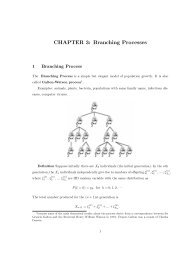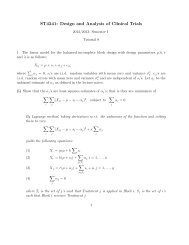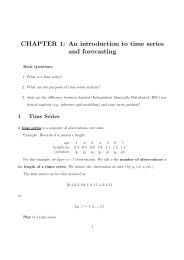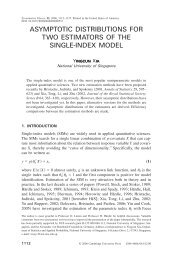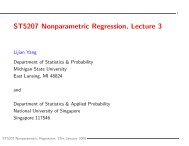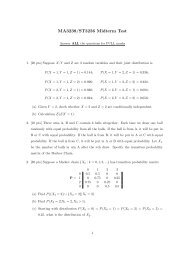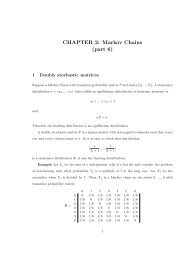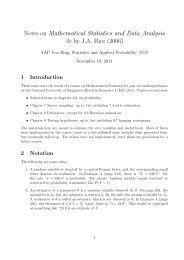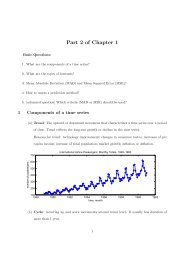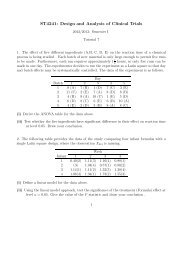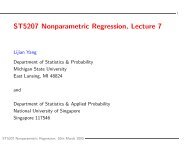Use Software R to do Survival Analysis and - The Department of ...
Use Software R to do Survival Analysis and - The Department of ...
Use Software R to do Survival Analysis and - The Department of ...
You also want an ePaper? Increase the reach of your titles
YUMPU automatically turns print PDFs into web optimized ePapers that Google loves.
estima<strong>to</strong>r) or equal <strong>to</strong> the number <strong>of</strong> subjects at risk (Gehan type estima<strong>to</strong>r) or other predictable<br />
functions.<br />
Remark: For two sample case, rank estimation equation is same as the logrank test. Recall for<br />
Buckley-James estima<strong>to</strong>r, it is equivalent <strong>to</strong> comparing the two means from two Kaplan-Meier estima<strong>to</strong>rs<br />
(t-test).<br />
<strong>The</strong> numeric solution <strong>of</strong> this equation can be difficult, except with Gehan type estima<strong>to</strong>r. In the<br />
Gehan case, the estimating functions are mono<strong>to</strong>ne in b, so the solution is easy.<br />
I wrote an R function, based on the Splus code <strong>of</strong> Z. Jin, <strong>to</strong> compute the Gehan estima<strong>to</strong>r. Download<br />
the package<br />
rankreg_0.2-2<br />
from CRAN.<br />
<strong>Use</strong> the function rankaft() inside the package <strong>to</strong> obtain the solution/estima<strong>to</strong>r. Caution: this<br />
function is memory hungary. For sample size around 600, you need 1G RAM.<br />
For statistical inference after the estima<strong>to</strong>r is computed, we can use empirical likelihood: This is very<br />
similar <strong>to</strong> the exponential regression case when we used the <strong>of</strong>fset() comm<strong>and</strong> <strong>to</strong> get the confidence<br />
interval or P-value; except here the likelihood been replaced by the empirical likelihood.<br />
I also wrote an R function for this purpose <strong>to</strong>o. <strong>Use</strong> function RankRegTest() inside the package<br />
emplik; you need version 0.9-2 or later.<br />
<strong>The</strong>re is also the possibility <strong>of</strong> using re-sampling method <strong>to</strong> obtain inference, but is relatively slower<br />
compared <strong>to</strong> the likelihood based method.<br />
Score test: <strong>The</strong> “score” test for the ˆβ in the rank based estimation is also simple:<br />
<strong>The</strong> idea is that if b = β 0 then the residuals are iid. <strong>The</strong>n the covariate values carried by the<br />
residuals should have no relation <strong>to</strong> how large a residual is.<br />
Condition on the residual values that are > t, suppose there are k such residuals. <strong>The</strong>y carry k<br />
covariates. <strong>The</strong> covariate that coresponding <strong>to</strong> the smallest residual out <strong>of</strong> the k remaining residuals<br />
should be equally likely <strong>to</strong> be any one <strong>of</strong> the k corresponding covariates.<br />
By the above argument, the null distribution <strong>of</strong> the Z i is uniform among Z j such that e j ≥ e i . <strong>The</strong><br />
second moment <strong>of</strong> the term Z i − ¯Z i is then<br />
σ 2 i = 1/k ∑ j<br />
(Z j − ¯Z i ) 2<br />
This is the variance <strong>of</strong> (one term <strong>of</strong>) the “score”. Successive term may be view as (conditionally)<br />
uncorrelated.<br />
This variance <strong>of</strong> the score is computed, also a related chi square (score test) statistic is returned by<br />
the function RankRegV inside the rankreg package.<br />
Remark: A similar arguement also works for Cox ‘score’. We only need <strong>to</strong> treat the observations<br />
there as exponential ran<strong>do</strong>m variables.<br />
10.3 Case-weighted regression estimation<br />
If we assume a ran<strong>do</strong>m design, we may view the (q+1) dimension vec<strong>to</strong>r (Y i , X i ) as iid. In this case we<br />
can use the weighted estimation method for the slope <strong>of</strong> the linear model. Sometimes the name IPCW<br />
(inverse-probability-<strong>of</strong>-censor-weight) is used <strong>to</strong> describe this weighting scheme.<br />
15



